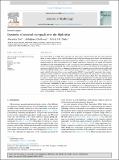| dc.contributor.author | Tuel, Alexandre | |
| dc.contributor.author | Chehbouni, Abdelghani | |
| dc.contributor.author | Eltahir, Elfatih AB | |
| dc.date.accessioned | 2021-10-07T14:36:14Z | |
| dc.date.available | 2021-10-07T14:36:14Z | |
| dc.date.issued | 2021 | |
| dc.date.submitted | 2020-06 | |
| dc.identifier.issn | 0022-1694 | |
| dc.identifier.uri | https://hdl.handle.net/1721.1/132771 | |
| dc.description.abstract | © 2020 Elsevier B.V. Snowpack melting in the High Atlas constitutes the major source of freshwater for the semi-arid agricultural plains of central Morocco. Snow runoff fills dams during spring and recharges groundwater, thus providing the necessary water for irrigation and hydropower production. Despite its critical importance for the region, basic questions about the High Atlas snowpack remain largely unanswered. In particular, the spatial and temporal distribution of snow water equivalent, as well as sublimation losses, potentially significant in this region, have yet to be thoroughly investigated. The scarcity of ground data has been a major obstacle to investigating snow processes in the High Atlas. Here, we demonstrate the potential of remotely-sensed meteorological variables and downscaled climate reanalysis data to gain important insights into snow water balance in a semi-arid region. We apply a distributed energy balance snow model based on SNOW17, constrained by topographic data, meteorological data from satellites and high-resolution dynamically-downscaled ERA-Interim data, to simulate snowpack dynamics within the Oum-Er-Rbia watershed, at the heart of Morocco's High Atlas. The simulations are compared to MODIS snow cover maps and observed snow depth at one field station. Results show that the spatial extent and temporal dynamics of snow cover at various elevation ranges are accurately captured. The snowpack is essentially concentrated above 2500 m, extends over 500–6000 km2 and holds 0.05–0.4 km3 at its peak in early February. Additionally, we find that losses by sublimation range from 0.06 to 0.14 km3 for an average of 0.09 km3 a year, about 10% of all snowfall. Above 3000 m elevation, sublimation removes on average 20% of the snowpack. Finally, we discuss the sensitivity of our results to uncertainties in the forcing meteorological data. This study reveals the essential components of the snow water balance in the High Atlas and paves the way for better understanding of its sensitivity to climate change. | en_US |
| dc.language.iso | en | |
| dc.publisher | Elsevier BV | en_US |
| dc.relation.isversionof | 10.1016/J.JHYDROL.2020.125657 | en_US |
| dc.rights | Creative Commons Attribution-NonCommercial-NoDerivs License | en_US |
| dc.rights.uri | http://creativecommons.org/licenses/by-nc-nd/4.0/ | en_US |
| dc.source | MIT web domain | en_US |
| dc.title | Dynamics of seasonal snowpack over the High Atlas | en_US |
| dc.type | Article | en_US |
| dc.identifier.citation | Alexandre Tuel, Abdelghani Chehbouni, Elfatih A.B. Eltahir, Dynamics of seasonal snowpack over the High Atlas, Journal of Hydrology, Volume 595, 2021 | en_US |
| dc.contributor.department | Parsons Laboratory for Environmental Science and Engineering (Massachusetts Institute of Technology) | |
| dc.relation.journal | Journal of Hydrology | en_US |
| dc.eprint.version | Author's final manuscript | en_US |
| dc.type.uri | http://purl.org/eprint/type/JournalArticle | en_US |
| eprint.status | http://purl.org/eprint/status/PeerReviewed | en_US |
| dc.date.updated | 2021-10-06T17:43:27Z | |
| dspace.orderedauthors | Tuel, A; Chehbouni, A; Eltahir, EAB | en_US |
| dspace.date.submission | 2021-10-06T17:43:29Z | |
| mit.journal.volume | 595 | en_US |
| mit.license | PUBLISHER_CC | |
| mit.metadata.status | Authority Work and Publication Information Needed | en_US |
